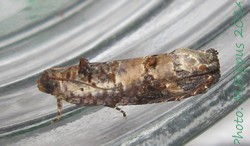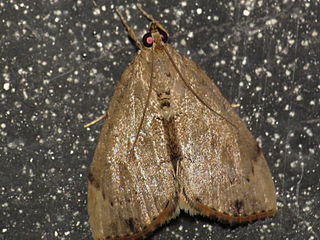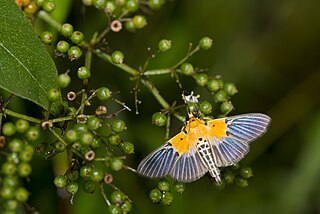
Myrmarachne is a genus of ant-mimicking jumping spiders that was first described by W. S. MacLeay in 1839. They are commonly called ant-mimicking spiders, but they are not the only spiders that have this attribute. The name is a combination of Ancient Greek μύρμηξ, meaning "ant", and ἀράχνη, meaning "spider".

Heteropoda is a genus of spiders in the family Sparassidae, the huntsman spiders. They are mainly distributed in tropical Asia and Australia, while at least one species, H. venatoria, has a cosmopolitan distribution, and H. variegata occurs in the Mediterranean.

Actinodaphne is an Asian genus of flowering plants in the laurel family (Lauraceae). It contains approximately 125 species of dioecious evergreen trees and shrubs.

Ancylolomia is a genus of moths of the family Crambidae described by Jacob Hübner in 1825.

Calamotropha is a genus of moths of the family Crambidae.
Cretonia is a genus of moths of the family Noctuidae. The genus was erected by Francis Walker in 1866.

Comostola is a genus of moths in the family Geometridae erected by Edward Meyrick in 1888. They are found primarily in Asia and Australia.

Plutodes is a genus of moths in the family Geometridae erected by Achille Guenée in 1857.

Tridrepana albonotata is a moth of the family Drepanidae described by Frederic Moore in 1879. It is found in India, Nepal, Vietnam, Sri Lanka, Peninsular Malaysia, Sumatra, Borneo, Java, Bali and Sulawesi.

Dudua aprobola, the mango flower webworm or litchi leaf roller, is a moth of the family Tortricidae. The species was first described by Edward Meyrick in 1886. It is a pest on several economically important crops.
Coleothrix swinhoeella is a species of snout moth in the genus Coleothrix. It was described by Ragonot in 1888. It is found in Taiwan, Burma, India, Sri Lanka, Borneo, Malaysia, Sumatra, Bali, Sulawesi, the Philippines and the New Hebrides.
Coleothrix longicosta is a species of snout moth in the genus Coleothrix. It was described by Yanli Du, Shimei Song and Chunsheng Wu in 2007. It is found in China, Japan, Burma, India, Sri Lanka, Borneo, Malaysia, Sumatra, Bali, Sulawesi and the Philippines.

Loryma recusata is a species of snout moth in the genus Loryma. It was described by Francis Walker in 1863 and is known from Taiwan, Indonesia, Sri Lanka, India, Thailand, western Malaysia and New Guinea. It has also been recorded from northern Australia and South Africa.
Ancylolomia indica, the Indian pale grass moth is a moth in the family Crambidae. It was described by Cajetan Felder, Rudolf Felder and Alois Friedrich Rogenhofer in 1875. It is found in India. It is externally indistinguishable from the nominate subspecies of Ancylolomia westwoodi. It is one of the most common species from the genus found in India.
Ancylolomia taprobanensis, the Chocolate grass-moth is a moth in the family Crambidae. It was described by Zeller in 1863. It is found in Mozambique, India and Sri Lanka, as well as on Java.

Crocidolomia suffusalis, the croci, is a moth in the family Crambidae. It was described by George Hampson in 1891. It is found in south-east Asia, where it has been recorded from India, Sri Lanka, China, Thailand, Malaysia, Java, Bali, Borneo, the Philippines and Taiwan. It is also present in New Guinea and Australia, where it has been recorded from Queensland and New South Wales.

Nevrina procopia is a moth in the family Crambidae. It was described by Stoll in 1781. The type locality is unknown. It is found from Sri Lanka, India, Bhutan, South China, Taiwan, southern Japan, Philippines, Malaysia, Singapore, Sumatra, Java, and New Guinea.
Pramadea lunalis is a moth in the family Crambidae. It was described by Achille Guenée in 1854. It is found in Taiwan, India, Sri Lanka, Myanmar, Borneo, Sulawesi, Sumbawa and Java. It is also found in Australia, where it has been recorded from the Northern Territory and Queensland.

Pycnarmon meritalis is a moth in the family Crambidae. It was described by Francis Walker in 1859. It is found in Democratic Republic of the Congo, South Africa, Australia, China, Sri Lanka, India, Indonesia, Taiwan and Japan.












